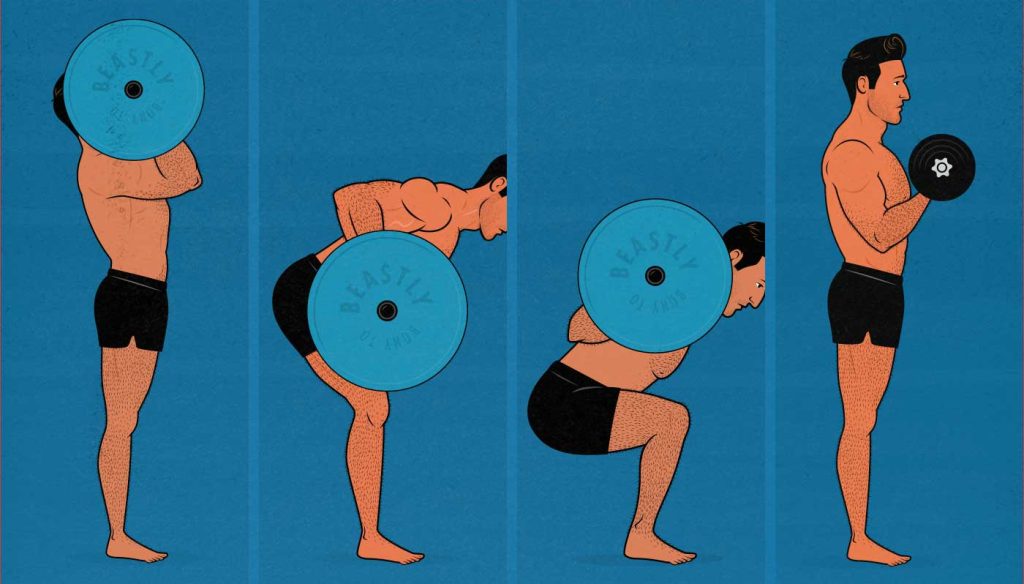
The Best Workout Splits for Gaining Muscle—Explained
A workout split refers to how you organize your exercises throughout the week. Should you do 2, 3, or 9 workouts? Should you stack all your chest exercises into one of those workouts, split them between two, or do a few sets every workout?
There are a few different workout splits, each of them good, but each with its own pros and cons:
- Body Part “Bro Split:” This split focuses on one body part per workout. Monday is Chest Day, Tuesday is Back Day, and so on. This type of split is incredibly popular with bodybuilders—and for good reason.
- Upper/Lower Split: This split severs your workouts into upper-body days and lower-body days. This split shifts more emphasis toward your lower body, making it great for gaining strength and athleticism. When Marco was helping professional and Olympic athletes bulk up, he had almost all of them on upper/lower splits.
- Push/Pull/Legs Split: This split organizes workouts by movement pattern. Pushing exercises work the triceps, chest, and shoulders. Pulling exercises target the back and biceps. Leg exercises focus on the entire lower body. It’s more logical than a Bro Split but also less clever and efficient.
- Full Body Split: You train your entire body every workout. It’s the most efficient way to train, allowing you to build a tremendous amount of muscle with just two or three workouts per week. I gained my first 50 pounds this way.
- Hybrid Splits: This split combines different ideas together. For example, maybe you add an upper/lower split to a push/pull/legs split, giving you a 5-day workout routine for gaining strength, athleticism, and muscle size. Or if your arms are lagging behind, you could add an Arm Day to your full-body routine.
Without further ado, let’s break all these splits down so you can find the one that’s best for you.
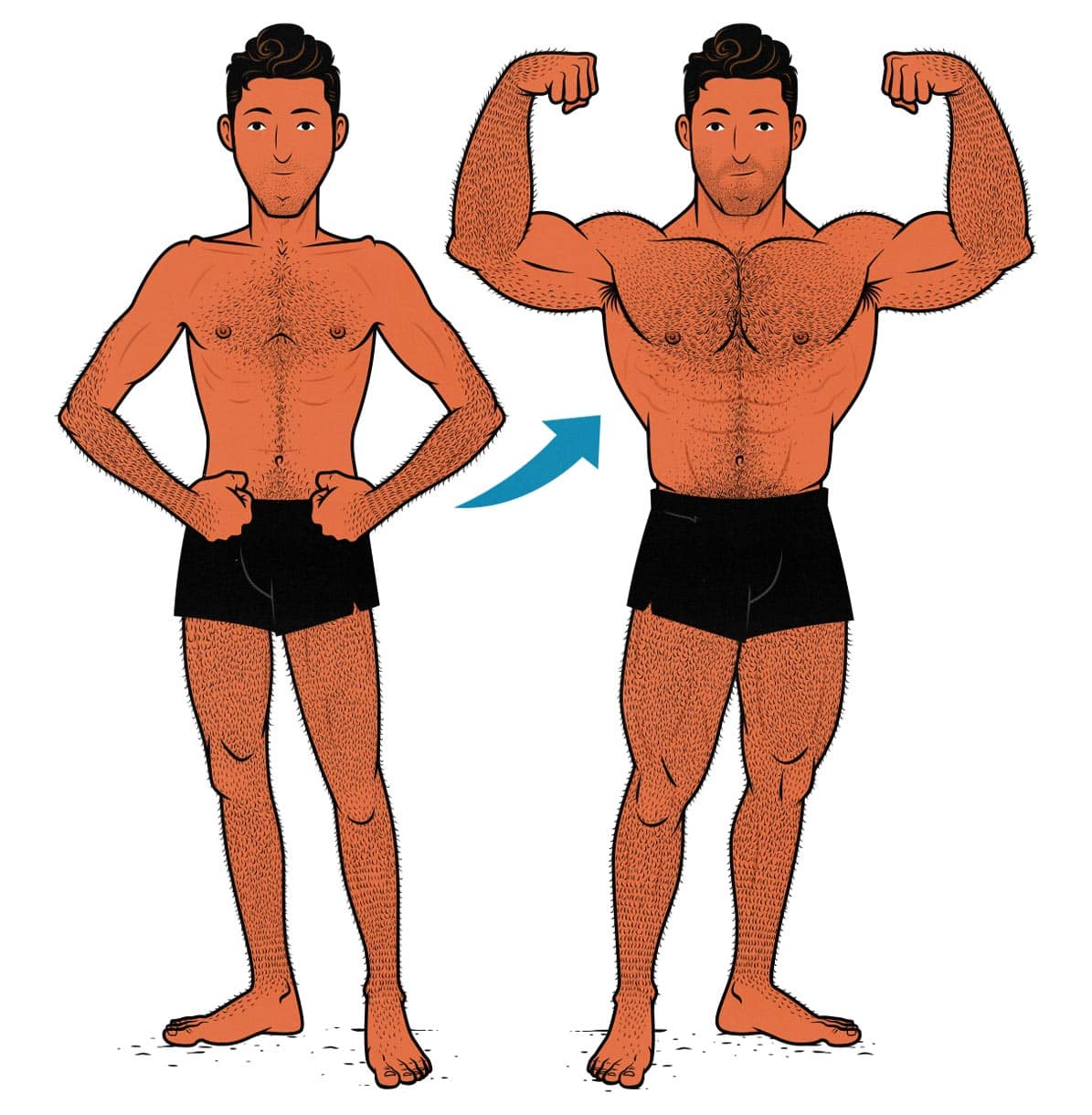
What’s a Workout Split?
A workout split is how you divide your exercises into workouts. The idea is to stimulate muscle growth, recover, and then stimulate more growth. You can do that by training all your muscles at once, having a full rest day, and then training them again (a full-body routine). You could also “split” your body up, training some muscles one day and others another day (a split routine).
There are a few good workout splits for building muscle, including:
- Full-Body Workouts: These workout routines stimulate most muscles during most workouts.
- Upper/Lower Splits: These routines split your workouts into lower-body and upper-body exercises.
- Push/Pull/Legs Splits: This is when you divide your workouts into pushing, pulling, and legs.
- Bro Splits: These are Push/Pull/Legs splits with extra days added for your arms and shoulders.
- Hybrid Splits: These are the mysterious workout splits used for more peculiar goals.
Each of these workout splits can stimulate the same amount of muscle growth. The latest meta-analysis found no inherent to any of them (explained here). It really depends on how much time you have, how strong you are, how fit you are, and what you’re trying to do.
I’ll break all the splits down, giving you some clear recommendations. But first, you need to understand the ideal training volume and frequency for provoking muscle growth. Once you know that, we can divide that volume into different workout splits.
How to Make a Workout Split
How Many Sets Should You Do?
Let’s start with how much you should train your muscles. Schoenfeld and colleagues found that our rate of muscle growth increases with every additional challenging set we do, at least to a point (study). If we look at another study by Aube and colleagues, we see that by the time you’re doing 6 sets per muscle per workout, we start building less muscle with every extra set (study).
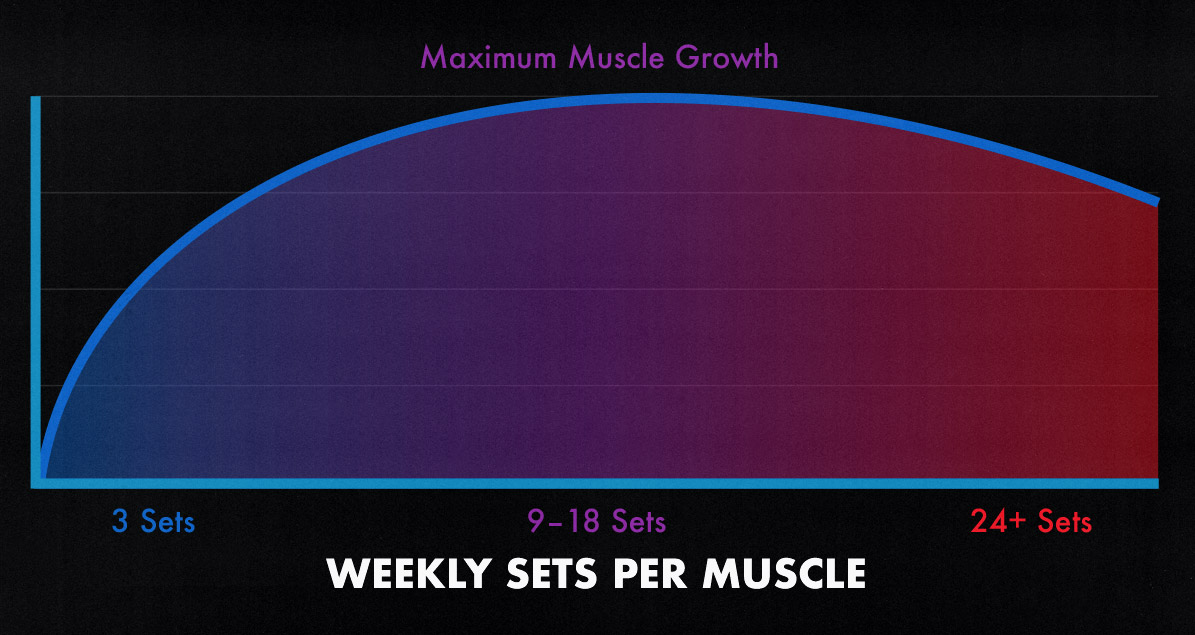
That gives us a relationship that looks something like this, with 9–18 sets per week yielding a maximal amount of muscle growth. The catch is that we need to spread that volume out so that we aren’t doing more than 6 sets per muscle per workout. For instance, doing 3 sets of bench presses on Monday, Wednesday, and Friday gives us 9 sets per week to bulk up your chest, which is perfect.
Now, there’s a caveat here. We’re assuming that you’re doing hypertrophy training, lifting in a way that’s ideal for building muscle.
- If your sets are too heavy (under 6) or light (over 40), you won’t stimulate muscle growth as efficiently and may need more sets.
- If your rest times are too short, your muscles won’t be able to do as much work, so you may need extra sets.
- If you aren’t choosing good exercises, you may not be challenging your muscles in as deep of a stretch, so you may need extra sets.
- If you take each set to total failure, you won’t be able to recover from as many sets.
9–18 sets per muscle group per week is a good default, but a little more or less is fine, and everyone is different. For beginners, 9 sets per muscle per week is a great place to start. (For more, we have a full article on training volume.)
How Often Should You Train Your Muscles?
The next thing to consider is how often you should train your muscles. We’re aiming for at least 9 sets for each muscle each week. But if we do more than 6 sets per muscle per workout, it stops being effective. In fact, it may begin to reduce your muscle growth. So, ideally, you want to split those 9+ sets into at least two workouts.
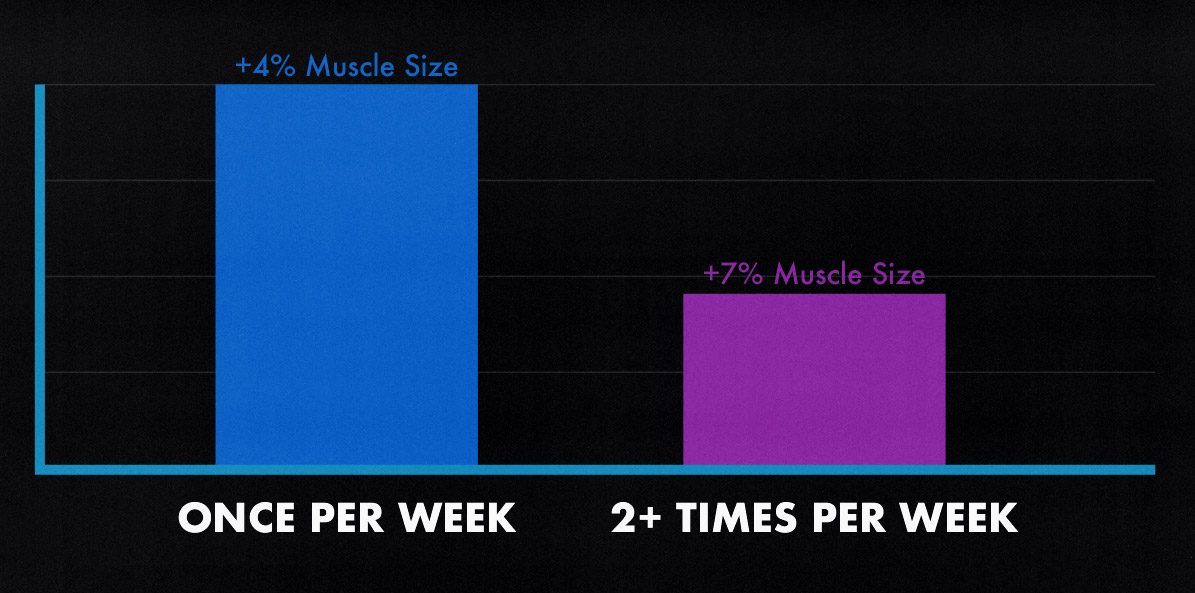
If we look at another meta-analysis by Schoenfeld and colleagues, we see that the logic holds (study). If we train our muscles at least twice per week, we gain muscle quite a bit faster than if we only train them once. When we’re training more than twice per week, though, it stops mattering. (For more, we have a full article on training frequency.)
How Long Should You Rest Between Workouts?
One of the main purposes of training splits is to let your muscles grow and heal between workouts. It usually takes around three days for a muscle to finish growing and healing. But it can take even longer if you’re new to training, taking your sets to failure, or doing a ton of sets for each muscle (study).
Here’s the part that few people talk about:
- Some parts of your body are stressed each workout, even if you aren’t training them directly. You hold the barbell in your hands whether you’re doing deadlifts or bench presses. You’re putting weight on your spine, whether you’re doing squats or overhead presses. Even if you split your workouts into different muscle groups, you may still hammer some areas every single workout.
- Even if your muscles have recovered, your tendons and joints may not have.
If you’re desperate to build muscle, it can be tempting to go all in. It can be tempting to lift in lower rep ranges, to bring every set close to failure, and to train as often as possible. That can be risky. It’s fine for building muscle in the short term—neither better nor worse than a more sensible approach—but it can take a real toll on your body in the longer term.
Everyone has different predispositions for injury. Many people get away with reckless training. But many people also wind up injured, aching, and nursing chronic injuries. It often helps to start with full rest days between workouts, only 3 sets per exercise, and only 3 workouts per week. That’s enough to stimulate a maximal amount of muscle growth but not so much that it starts truly beating you up.
Your muscles usually recover within 1–3 days, especially once you get used to your training routine. Some training splits are designed to allow you to train every day, alternating between different muscles. Those can be great, but as a beginner, it’s often best to take full days of rest between your workouts.
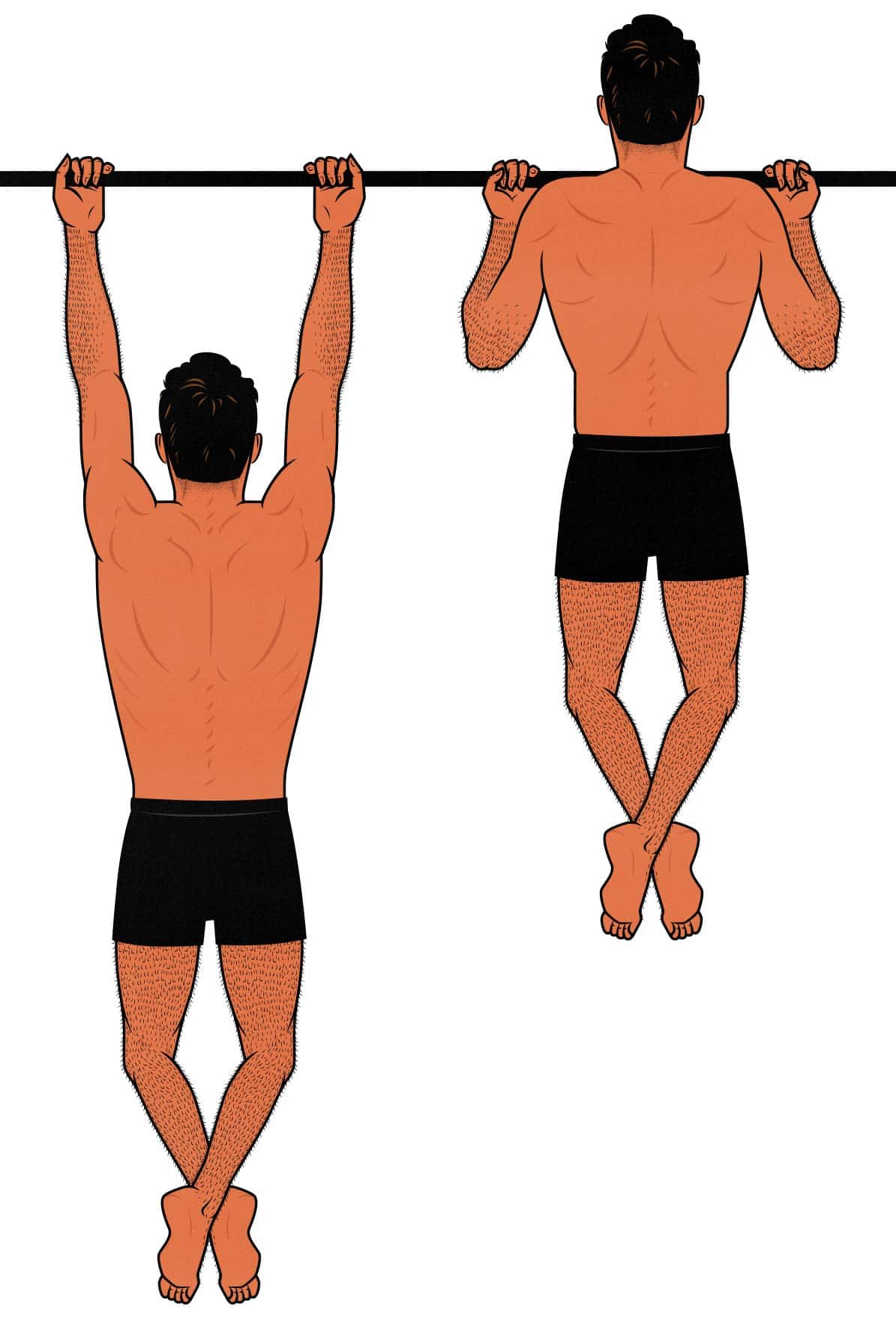
Splitting Up Your Training Volume
To maximize your rate of muscle growth, you need to train a muscle at least twice per week, accumulating at least 9 challenging sets for that muscle. That gives us a ton of freedom when designing our workout splits.
For example, if you did 5 sets of squats, push-ups, deadlifts, and chin-ups twice per week, you could build a tremendous amount of muscle. It works incredibly well for most beginners. Mind you, those 4 exercises don’t train every muscle. Your biceps, triceps, side delts, calves, and neck muscles would fall behind. You could do better by adding a third workout, allowing you to add more exercise variety.
On the opposite side of the spectrum, you could train multiple times per day, breaking your body down into tiny muscle groups. You could train your biceps Monday morning, your triceps Monday afternoon, and so on, slowly working through every muscle in your body. This way of training is inefficient, but it works. In fact, Arnold Schwarzenegger used a workout split like this.
So, how do you pick your workout split? It depends on your experience level, your goals, and your preferences. Each split has its own advantages and disadvantages.
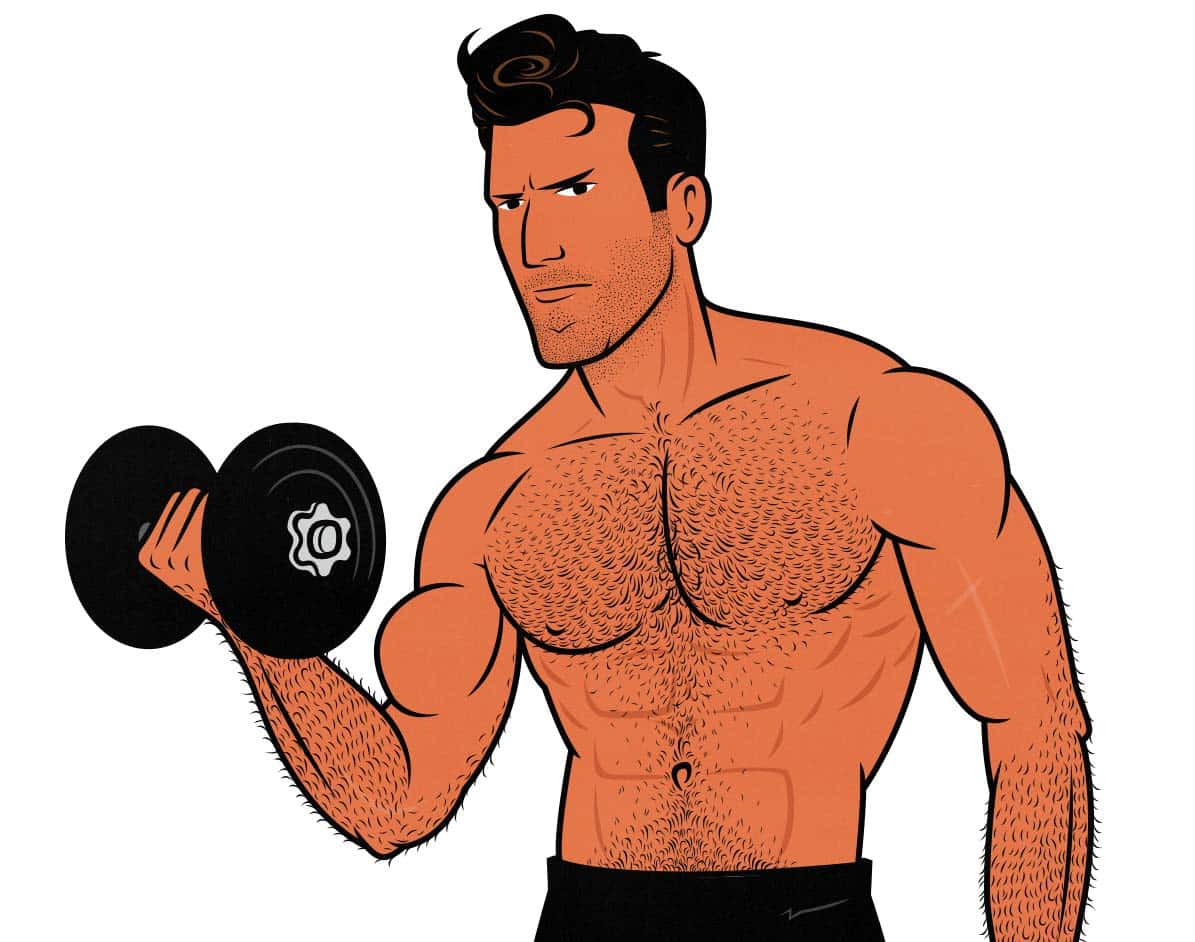
Full-Body Workout Splits
Full-body workouts are usually ideal for beginners who are trying to build muscle, gain strength, and improve their health. They’re a great default during your first couple of years of lifting. (I gained my first 40 pounds with full-body workouts.)
What’s a Full-Body Workout?
A full-body workout is one where you train most of the muscles in your body. For instance, if you do a goblet squat, bench press, Romanian deadlift, and chin-up, you haven’t trained your neck or calves, but it still counts as a full-body workout.
The big compound lifts are incredibly good for packing on muscle mass. Full-body workouts have you doing all of them every 2–3 days, allowing you to gain muscle at a tremendous pace.
Full-body workout routines aren’t always training splits. Some full-body routines will have you repeating the same exercises every workout. That can be ideal for practicing the big compound exercises, making it great for beginners.
Most full-body workout routines are splits. Each workout still trains every major muscle group, but they do it with different exercises. Maybe one workout, you do goblet squats, bench presses, chin-ups, biceps curls, and triceps extensions. Then the next workout, you do Romanian deadlifts, push-ups, rows, lateral raises, and crunches. You get less practice with each exercise, but you get a wider variety of them, giving your workout routine greater balance. This tends to be ideal for intermediate lifters.
Some routines try to get the best of both worlds. For example, Starting Strength begins each workout with back squats but alternates between different pressing and pulling movements. That gives you more practice on the hardest lift (the squat) and less on easier lifts (like the bench press). We take a similar approach. We practice the difficult movements (like squats, push-ups, and chin-ups) while alternating the isolation movements (like biceps curls, triceps extensions, and lateral raises).
Most full-body routines are done 3x per week, like so:
- Monday: full-body workout.
- Tuesday: rest.
- Wednesday: full-body workout.
- Thursday: rest.
- Friday: full-body workout.
- Saturday: rest.
- Sunday: rest.
Advantages of Full-Body Workouts
- There’s a huge emphasis on the big compound lifts. If you need to train your entire body in a single workout, you need to rely on compound lifts. These compound lifts are incredible for building muscle.
- Full-body workouts are the most efficient way to build muscle. Every workout, you’re stimulating growth in every muscle. Even with just three workouts per week, you can build muscle at full speed.
- Full-body workouts are amazing for gaining strength. Frequent practice is a huge aspect of improving your coordination. If you’re squatting, benching, and deadlifting three times per week, your strength and skill will improve extremely fast.
- There’s plenty of emphasis on recovery. There’s a full day of rest between each workout, giving your muscles, joints, and tendons plenty of time to recover. This is especially important for beginners, who may not have built up much toughness yet.
Disadvantages of Full-Body Workouts
- They leave less time for isolation lifts. After doing compound lifts for all your major muscle groups, you won’t have much energy left for isolation lifts. For beginners, this doesn’t matter very much. For intermediate and advanced lifters, getting stronger at isolation lifts is an important part of developing all of your muscles.
- As you get stronger, lifting weights becomes more tiring. You need to do more warm-up sets, lift more weight, do more sets, and add in more isolation lifts. Trying to fit all of that into just three workouts per week gets hard.
- Full-body workouts don’t suit higher training frequencies very well. You could do five full-body workouts per week, choosing different exercises each workout. But at that point, it’s hard for your joints and tendons to recover. If you want to train more often, training splits are usually better.
- The workouts can be long. Most full-body workouts take at least 45 minutes, and 90-minute workouts aren’t uncommon.
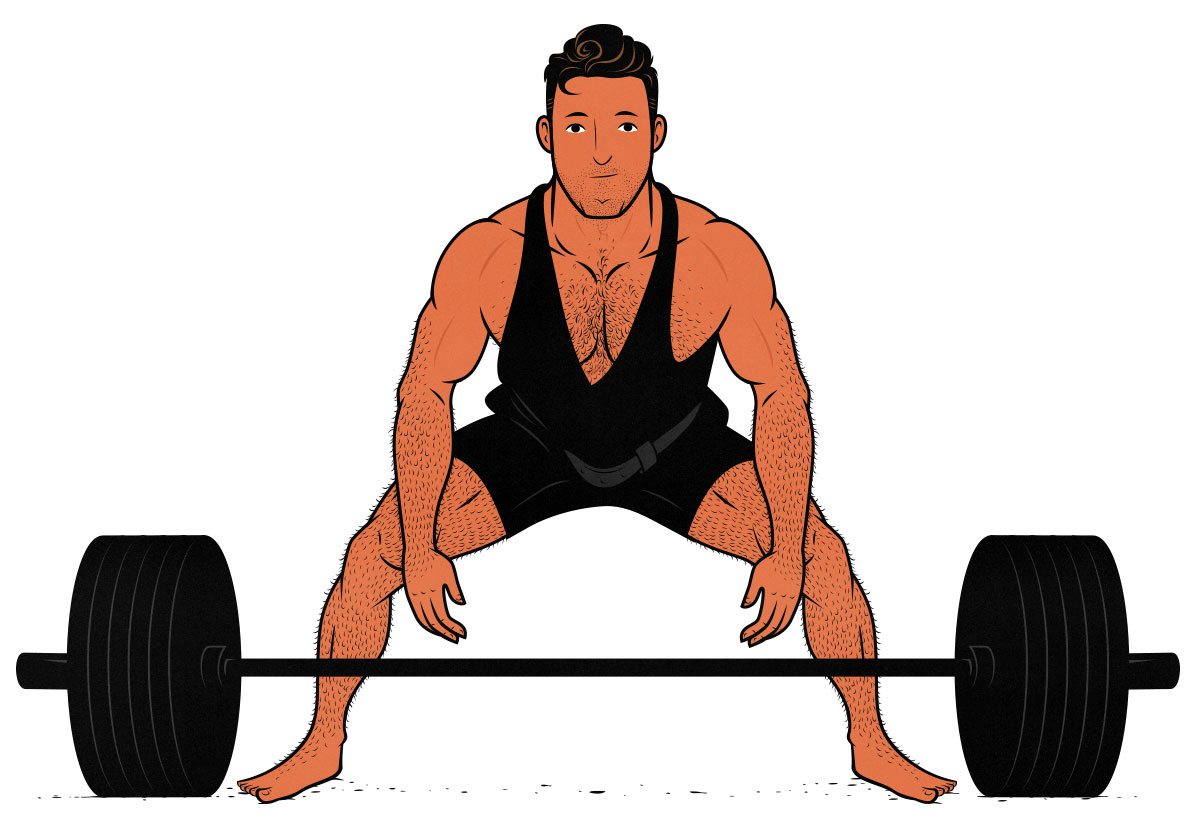
Upper/Lower Splits
Upper/Lower Workout Splits are ideal for intermediate and advanced athletes, bodybuilders, and powerlifters who want to put extra emphasis on bulking up their legs.
When Marco trains college, professional, or Olympic athletes, he almost always uses upper/lower workout splits. They’re incredibly good for improving athletic performance, especially in sports that involve running and jumping.
What’s an Upper/Lower split?
An upper/lower split has you dividing up your workouts into upper-body and lower-body workouts. For instance, maybe you do squats, Romanian deadlifts, and calf raises during your lower-body workouts and bench presses, chin-ups, and arm exercises during your upper-body workouts.
The 4-Day Upper/Lower Split
The classic upper/lower split will have you training 4 days per week, like so:
- Monday: Upper Body
- Tuesday: Lower Body
- Wednesday: Rest
- Thursday: Upper Body
- Friday: Lower Body
- Saturday: Rest
- Sunday: Rest
This is a great workout split for intermediate lifters beginning to struggle with full-body workouts. It spreads the workload out, making each workout easier. It also adds extra emphasis to lower-body training, which can be helpful for most sports.
The 6-Day Upper/Lower Split
Some advanced bodybuilders prefer a 6-day version of the upper/lower split.
- Monday: Upper
- Tuesday: Lower
- Wednesday: Upper
- Thursday: Lower
- Friday: Upper
- Saturday: Lower
- Sunday: Rest
The Advantages of Upper/Lower Splits
- You get an extra 1–3 days in the gym, giving you more freedom to do shorter workouts or add in more isolation exercises. It also spreads out the effort, making each workout easier.
- Upper/lower splits emphasize the lower body, which is great for athletes who need a ton of lower-body power. Think rugby or football players. It’s also great for bodybuilders who are trying to build huge legs. And for powerlifters who are eager to gain squat and deadlift strength.
The Disadvantages of Upper/Lower Splits
- You need to spend 1–3 extra days in the gym.
- Some areas of your body get stressed every workout, including your hands, core, and spine. You can mitigate this by choosing lighter lifts with less axial loading (like split squats instead of squats) or using exercise machines (like the leg press).
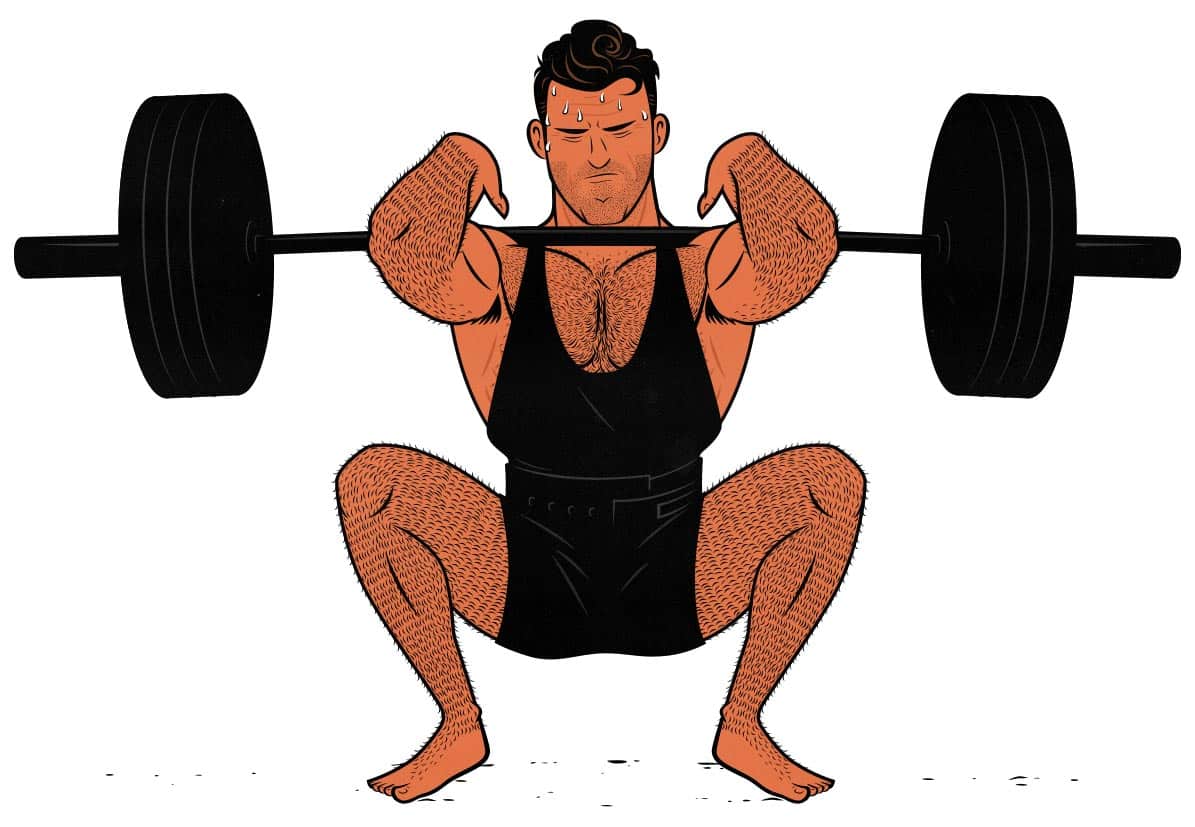
Push/Pull/Legs Workout Splits
Push/Pull/Legs splits can be great for advanced lifters and bodybuilders. They’re also ideal for recreational lifters who prefer doing short workouts every day instead of longer workouts every second day.
What’s a Push/Pull Leg Split?
Push/pull/legs workout splits divide your body into pushing muscles (chest, shoulders, and triceps), pulling muscles (back, biceps, and hamstrings), and leg muscles (glutes, quads, and hamstrings). These muscle groups work well together:
- Push Day: Where you train your chest, shoulders, and triceps with pressing exercises like push-ups, bench presses, and overhead presses, then do triceps extensions and lateral raises.
- Pull Day: Where you train your back, biceps, and abs with chin-ups, rows, biceps curls, and wrist curls.
- Leg Day: Where you train your legs with squats, deadlifts, and calf raises.
3-Day Push/Pull/Legs Splits
The 3-day Push/Pull/Legs split is incredibly popular, but it only has you training each muscle once per week. That’s not enough to maximize your rate of muscle growth (research breakdown). If you’re only training 3 days per week, I’d do a full-body workout routine instead.
- Monday: Push Day.
- Tuesday: rest.
- Wednesday: Pull Day.
- Thursday: rest.
- Friday: Leg Day.
- Saturday: rest.
- Sunday: rest.
6-Day Push/Pull Legs Splits
The 6-day Push/Pull/Legs split is less common but more effective. You could use it to increase your training volume, doing rigorous workouts every day. You could also use it to shorten your workouts, doing just a couple of exercises each session.
- Monday: Push Day.
- Tuesday: Pull Day.
- Wednesday: Leg Day.
- Thursday: Push Day.
- Friday: Pull Day.
- Saturday: Leg Day.
- Sunday: rest.
The Advantages of Push/Pull/Legs Splits
Push/Pull/Legs workout splits have a few notable advantages:
- Push/pull/legs splits put proportional emphasis on the upper body, which is great for improving your appearance. A Push Day can include the bench press, overhead press, and triceps extensions. Pull Day can include chin-ups, rows, and biceps curls. Leg Day can include squats, Romanian deadlifts, and calf raises. All the big compound exercises and muscle groups can be trained with ferocious fervour.
- 6-day splits spread out your effort, giving you the freedom to do shorter, easier workouts or add in more isolation exercises.
The Disadvantages of Push/Pull/Legs Splits
- The training frequency is too low if you’re only training 3 days per week.
- Some areas of your body get stressed every workout, such as your hands, core, and spinal erectors. If you’re careful, you can solve this with clever exercise selection.
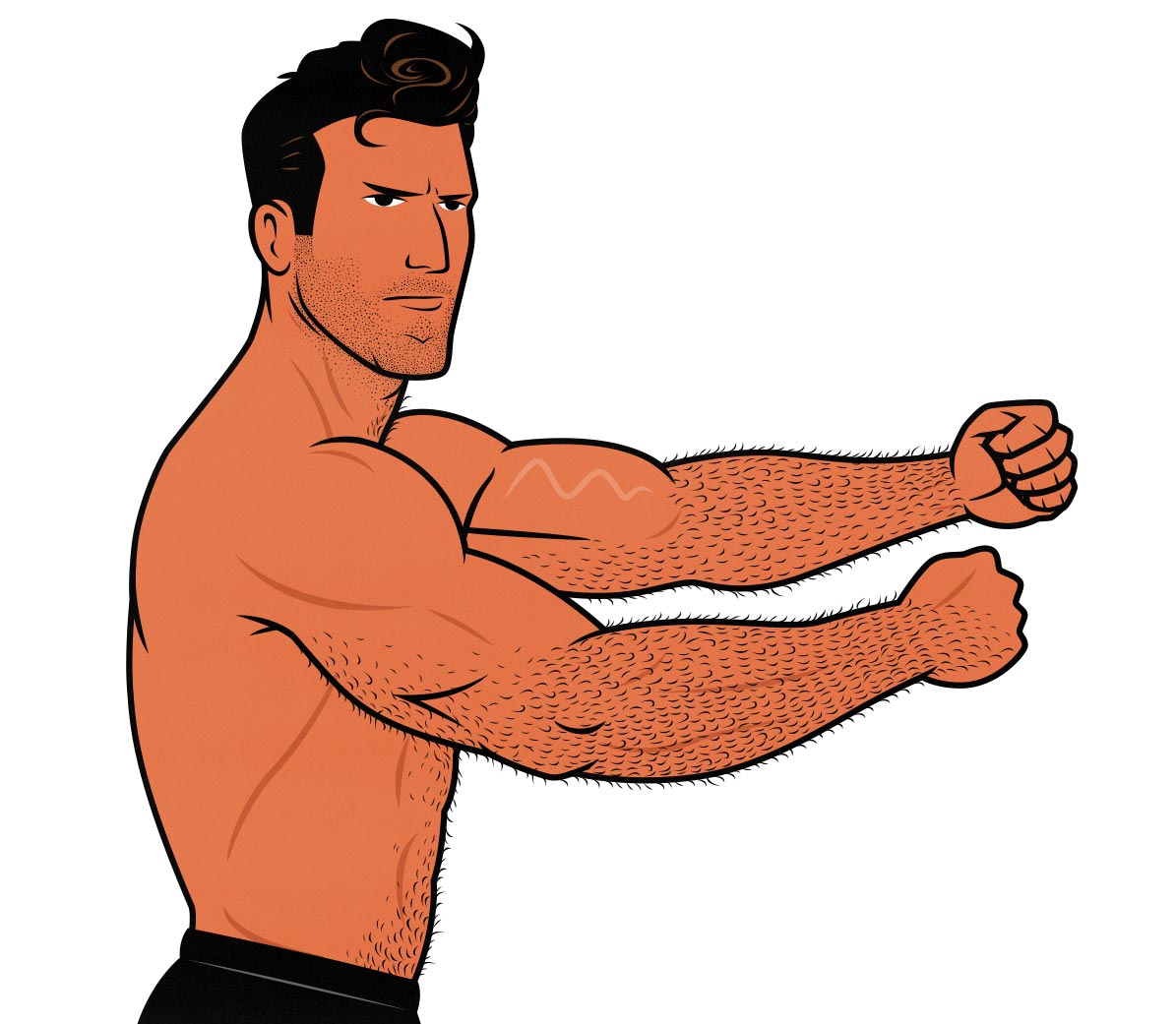
The Body Part “Bro Split”
Bro Splits aren’t the best workout split for beginners or athletes, and they don’t leave much room for cardio, but they’re fantastic for bodybuilding. If your main goal is to build muscle and improve your appearance, it’s hard to do much better than a clever Bro Split.
The Bro Split is by far the most popular workout split among bodybuilders, ranging from the bros to the pros. It’s often criticized for being unscientific, and that’s true, but it’s a traditional bodybuilding routine that’s been refined over many decades. There’s wisdom in it.
What’s A Bro Split?
Bro Splits are similar to 3-day push/pull/leg splits, except there are extra days for arms and shoulders. They look like this:
- Monday: Chest Day
- Tuesday: Back Day
- Wednesday: Leg Day
- Thursday: Shoulder Day
- Friday: Arm Day
- Saturday: Rest
- Sunday: Rest
The Advantages of Bro Splits
- You can train your upper-body muscles 2–3 times per week. To do this, include some compound lifts on Arm Day and Shoulder Day. Think of chin-ups for your biceps, close-grip bench press for your triceps, and overhead presses for your shoulders.
- Your arms get extra emphasis. It’s common for skinny guys to have thinner, lagging arms. That was certainly the case for me. The Bro Split solves that problem with a dedicated Arm Day, where you prioritize smaller lifts ideal for building bigger arms: close-grip bench, skull crushers, biceps curls, and forearm exercises.
- The workouts are slightly easier. Because of the extra training day, you aren’t trying to cram as much work into each workout.
The Disadvantages of Bro Splits
- Bro Splits aren’t as efficient as full-body workouts. You have to spend an extra 1–2 days in the gym.
- Your legs aren’t trained often enough. One Leg Day per week isn’t enough to maximize the rate of muscle growth in your legs. That’s okay for most bodybuilders. It’s less ideal for people interested in athletics and fitness.
- The big compound lifts are only done once per week. That can be an advantage for advanced lifters moving serious weight, but it’s a disadvantage for beginners trying to improve their coordination.
Hybrid Workout Splits
There are a million different workout splits, and you can invent any style you want. You could combine an upper/lower split with a push/pull/legs split, creating a 5-day workout split.
My favourite hybrid split is a 4-day workout routine combining full-body workouts with an upper/lower split, like so:
- Monday: Full Body
- Tuesday: Rest
- Wednesday: Full Body
- Thursday: Rest
- Friday: Lower Body
- Saturday: Upper Body
- Sunday: rest.
The heavy squats and deadlifts get their own day, keeping that work short, focused, and heavy. That frees up room for a fun Saturday where I can do my favourite upper-body lifts without worrying about my lower body. This is one of the options in our Outlift Intermediate Bulking Program, and it’s how I gained my last 15 pounds of muscle.
Summary
As a general rule of thumb, beginners benefit from fewer sets and more days of full recovery. This biases them towards full-body workouts. Intermediates, on the other hand, are lifting more weight, their training is more tiring, and they benefit from doing slightly more sets. As a result, they can benefit from splitting their work up over more days, which is where Upper/Lower Splits, Push/Pull/Legs Splits, and Bro Splits come in.
- 3-Day Full-Body Workout Routines: ideal for beginners who want to get bigger and stronger. A good default is to do these full-body workouts three times per week with 1–2 days of rest between each workout.
- 4-day Upper/Lower Splits: ideal for athletes and intermediate lifters who want to emphasize their legs.
- 4–5 day Bro Splits: ideal for intermediate and advanced bodybuilders who want to emphasize their upper-body aesthetics.
- 6-day Upper/Lower Splits: ideal for advanced lifters who want to emphasize their legs.
- 6-day Push/Pull/Legs Splits: ideal for advanced bodybuilders who know how to manage their recovery. Also ideal for experienced recreational lifters who enjoy doing short daily workouts.
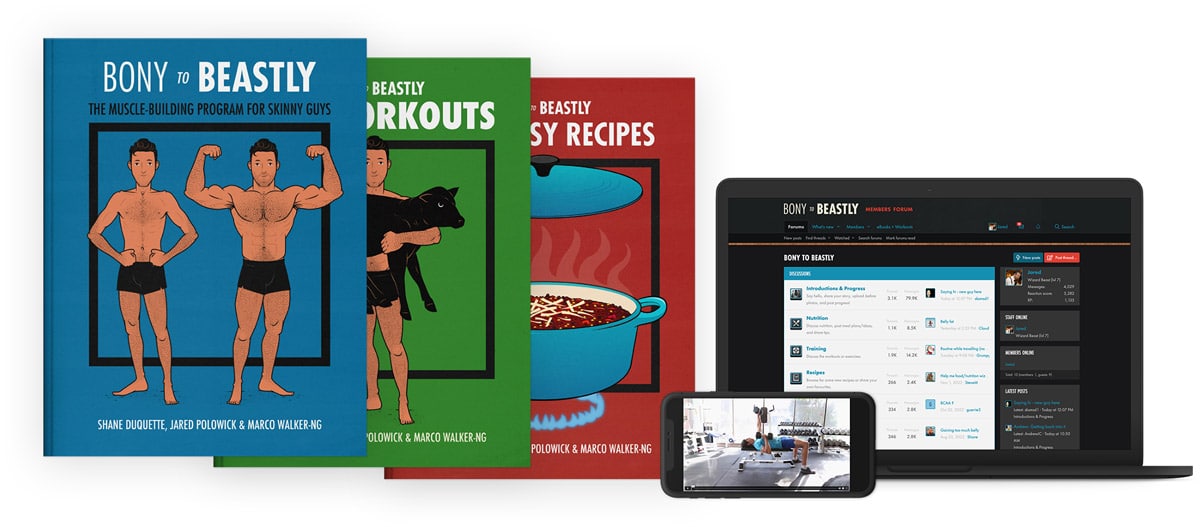
Alright, that’s it for now. If you want to know the ins and outs of bulking up, we have a free newsletter. If you want a full muscle-building program, including a 5-month workout routine, a bulking diet guide, a gain-easy recipe book, and online coaching, check out our Bony to Beastly Bulking Program. Or, if you want a customizable intermediate bulking program, check out our Outlift Program.
Muscle-Building Mini-Course via EMAIL
Sign up for our 5-part muscle-building mini-course that covers everything you need to know about:
- Hardgainer genetics and how to make the most of them.
- How to take a minimalist approach to building muscle while still getting great results.
- What you need to know about aesthetics, health and strength while muscling up.



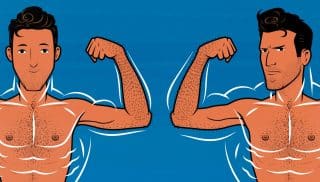
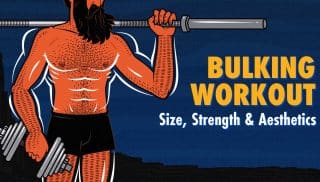
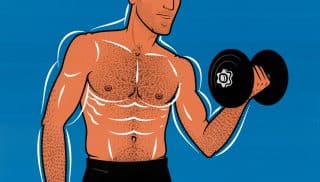
I just found this site and there is so much great info!
What do you think of having an “A” workout and a “B” workout and alternating between the two, with a rest day on between? A, rest, B, rest, A, rest, B etc.
Workout A: 4×8 bench, 3×15 row, 3×6 deadlift, 3×12 skullcrushers, 3×10 hanging leg raises.
Workout B: 4×8 chinups, 4×8 OHpress, 4×8 squat, 3×12 curls, 3×12 lateral raise.
I love the simplicity but would like to hear your thoughtsin regards to optimizing hypertrophy.
Thanks!
Hey Spencer, thank you so much!
Yeah, totally. A/B workout routines can be perfect. Your version of it looks absolutely killer, too. You’ve got great full-body workouts there, both are balanced, your exercise selection is great, and both workouts complement each other well. That’s exactly how to do it 🙂
Thanks Shane. This site and Outlift are like a two-stop shop for all of my hypertrophy training needs!
😀
Another great article!
I’m currently doing a push/pull/legs routine, started this month together with a serious diet for the first time. Before this I’ve been lifting for 2 years more or less, never on a diet regimen and most probably always under-eating. I have done almost always full body workouts.
My push/pull/legs split is a 4 days workout divided in:
Monday: legs
Tuesday: chest + triceps
Wednesday: rest
Thursday: back + biceps
Friday: Shoulders
Saturday: rest
Sunday: rest
I switched to a push/pull/legs because I thought the stimulus to each muscle in a workout day wasn’t enough on a full body workout.
Now, I would gladly switch back to a full body workout routine, but I have a question: when I was on a 3 days full body routine I remember going to the next workout not feeling fully recovered, especially my legs. The way I’m used to train is trying to lift the most I can for each given sets x reps (e.g. if I have a 4×8, I’ll lift with weights I know I won’t be able to lift to 8 reps on my last and usually also second last sets, so in the end it might look like 8-8-7-6 reps, sometimes 8-8-7-5). This applies to every exercise of a workout. Can this method be still applied to a full body or should I change it? One thing to note is that when I was doing full body workouts I wasn’t on a diet and was not taking creatine.
The workout routine I have in mind will be something like this:
Monday: bench press 3×8, inclined bench flyes 2×10, lat machine/pull ups 3×8, barbell rows reverse grip 2×10, military press 3×8, squats 3×8, leg curl 2×10, curls 3×8-10, push down 3×8-10
Tuesday: rest
Wednesday: T-bar/pulley 3×8, lat machine reverse grip/chin ups 2×10, inclined bench press 3×8, cable flyes 2×10, lateral raises 3×10, deadlifts 3×8, leg extension 2×10, french press 3×8-10, curls 3×8-10
Thursday: rest
Friday: chest press 3×8, inclined bench flyes 2×10, lat machine/pull ups 3×8, dumbell rows 2×10, military press 3×8, leg press 3×8, romanian deadlifts 2×10, curls 3×8-10, push down 3×8-10
(abs at the end of each workout, usually hanging legs raises 4-5×12)
The goal is to maintain the weekly volume per muscle of my current push/pull/legs routine but amping up the frequency. What do you think? Will I find beneficial switching to a full body after a month of push/pull/legs? I have had my modest gains this month, but if I can further maximize them then even better.
Thank you, and again, awesome article.
I think a full-body routine could work well for you. So could a body-part split. It’s really up to you. You’d just want to make sure that you’re training the muscles you’re most eager to grow 2–3 times per week. With your current split, you’re only training your legs and back once per week, so you’ve got some room for improvement there. If you’re trying to emphasize your chest and shoulders, though, you’re hitting those muscles twice per week with twice the volume, so you’d expect it to be pretty solid for those muscles.
Your rep scheme sounds fine. It’s okay to train hard. But when you switch over to a full-body workout routine, you might want to start with just a couple sets per exercise and stop 1–2 reps shy of failure on your sets. Then, as the weeks go by and you adapt to the routine, you can add more sets and push yourself harder.
It’s normal to feel a bit sore in the muscles you worked the hardest. That’s why a lot of full-body splits will emphasize different muscles each workout. Maybe one full-body workout hits your chest pretty hard with the bench press, leaving your chest feeling sore. Maybe the next workout focuses on overhead presses instead. Both workouts are full-body, but they aren’t hammering the same lifts or emphasizing the same muscles.
If you eat in a calorie surplus and you gain a little bit of weight each week, you’ll recover faster and build more muscle. I think that should help, too 🙂
The frequency is exactly what made me change my mind. I don’t like that I have to wait a week to train my back, or my chest again, but I wrongfully thought that splitting completely was for the best.
I will definitely keep frequency in mind and I’ll probably start next week with the new routine. I’ll see how it goes and if working out each muscle every workout day is too much I guess I can go for something similar to what Spencer suggested in the comments, so an A-B routine in 4 days where I can better distribute the exercises to train the same muscle at least twice a week.
I am indeed in a caloric surplus, so I hope this time I’ll have a faster recovery rate.
Thanks!
Hi there Shane,which type of full body split do you think it’s better?
Classic full body split alternating days?
Day A: Bench press:3×6-barbell row:3×6-squats:3×6-biceps curl:3×15-leg gurl:3×15-lateral raises:3×15.
Day B: Shoulder press:3×6-chinups:3×6-deadlifts:3×6-triceps extension:3×15-leg extension:3×15-chest flyes:3×15.
Or this one?
Day A
Bench press:3×6
Rows:3×6
Shoulder press:3×6
Chinups:3×6
Deadlift:3×6
Squats:3×6
Biceps curl:2×15
Triceps extension:2×15
Lateral raises:2×15
Day B
Bench press:3×10
Row:3×10
Shoulder press:3×10
Chinups:3×10
Squats:3×10
Deadlift:3×10
Biceps curl:2×15
Triceps extension:2×15
Lateral raises:2×15
Day C
Bench press:3×15
Row:3×15
Shoulder press:3×15
Chinups:3×15
Squats:3×15
Deadlifts:3×15
Biceps curl:2×15
Triceps extension:2×15
Lateral raises:2×15
Hey David, there’s no single right answer. Your first option has fewer exercises, giving it a lower training volume. Volume is a factor. Some people tolerate lower volumes better. Others respond better to higher training volumes. Both of those routines have reasonable training volume. But if one works better than the other for you, it might be due to the difference in volume.
As a beginner, practicing the lifts more frequently tends to help people learn them faster. Your second routine is good for that. You’re getting frequent practice with the big compound lifts. If you’re a beginner, I think the first routine would serve you well, especially if you aren’t that strong and you’re using relatively short rest times. That way you’re able to get through those marathon workouts in a reasonable amount of time. Having those different rep targets for each workout adds a bit of variety, too. That’s nice.
Beyond the beginner level, I usually prefer splits that have different exercises. That way you aren’t always hammering the same muscle fibres, joints, and tendons every single workout. It’s a bit less finicky. Harder to mess up. And you get to have a wide variety of exercises in your routine without needing to do nine exercises every workout. So if it were me choosing a routine for myself, I’d pick the first one.
Hey Shane,
My schedule can be jam packed and also occasionally changes on short notice. There aren’t often times that this happens, but there will be weeks where despite having the best intentions to do an every other day sorta split, I have to move one of the workouts. It ends up looking like lifting Monday, Tuesday, Thursday, for example, instead of the ideal Monday, Wednesday, Friday. My question is: is there any idea what the consequences of moving workouts around like that are? And if so, is there a better, more efficient way that I can be flexible when needed and still get the most out of lifting and resting?
Love the program and these articles, dudes!
Hey Connor, thank you!
What you’re doing is fine. It’s okay to train two days in a row, even when you’re training the same muscles. It won’t make your muscles fall off or anything. The downside is that you won’t have fully recovered from the first workout, so it will be harder to perform as well in the second workout. That’s more of a problem for strength than for size, but it’s not quite ideal for either.
One solution is to do all the upper-body lifts one day, the lower-body lifts the next day. That way you’re training two days in a row, but you aren’t training the same MUSCLES two days in a row. The downside is that you’d need some pre-planning. It doesn’t work well when your schedule is moved around on short notice.
Another solution is to shift your workouts later in the week instead. If you can’t train on Wednesday, you’d train on Monday, Thursday, and Saturday. You still get your three workouts in, and you still have a day of rest between each of them. There’s no downside here, but it’s not always feasible.
Finally, you could just delay your routine. If you need to skip Wednesdays workout, you’d do that workout on Friday instead. You don’t SKIP any workouts, you DELAY them. The routine gets shifted back. If you aren’t tied to a 7-day schedule, you can just shift things back a day. The downside is that you’re training with reduced frequency and volume, reducing your overall rate of muscle growth. The effect should be modest, but it’s not perfect, and it’s not as good as what you’re already doing.
So, overall, I think your solution is already good. It’s the best way to make the most of an imperfect situation. You’ll do great. I don’t think you’ll notice any different in muscle growth. The only thing you’ll notice is that sometimes your workout performance will be reduced.
But if you can manage it, you can fix the issue even more smoothly by shifting your routine back a day, lifting on Saturday, and then starting up the new week on Monday, just like always.
I am 6 foot tall and weigh 53kg. I find it hard to gain weight, and I found this article very helpful.
I did a push/pull/legs workout split for 3 months, but I am still researching for the best workout routine. I want to find one I can follow for at least 4-6 months.
Can you suggest the best workout split for my physique? Full body? Push/pull/legs?
I am doing bodyweight training: push-ups, squats, and a 30-minute fast walk in the park.
Can I do 30 minutes of fast walking before my workouts, or will it affect my gains?
Hey Thakur,
The 3-day full-body workout routine is ideal for most beginner and early intermediate lifters. It’s an incredibly powerful workout split for stimulating muscle growth. The only downside is that the workouts can get quite challenging as you grow bigger and stronger. At that point, you can spread the workload out over more days, switching to a 4-day or maybe even a 5-day split. Or, if you want to keep training 3 days per week, you could do specialisation routines, where you focus more on some lifts than others.
If you prefer to train more often, you could look at the other splits, choosing the one that gives you the training frequency you enjoy.
As for the walking, We’ve got an article about how cardio affects muscle growth. Just keep in mind that walking isn’t overly tiring. It won’t interfere with lifting to the same extent as more intense cardio (such as jogging). I’m not sure it will interfere at all. Still, if you don’t want to risk losing any gains, you could go on walks in the morning and lift in the evening, or vice versa.
One of my best bulks was when I’d walk 15 minutes to the gym and 15 minutes back. I was walking at a leisurely pace. It wasn’t tiring. I would go on faster walks on non-lifting days.
Walking is incredibly good for improving your health and fitness. Definitely keep it up.
Keep it ALL up. Sounds like you’re doing great!
great article
Hi Shane,
I’m currently doing a 3-day full-body routine that looks like this:
Monday
Barbell bench press: 4×6
Seated row: 4×8
Leg curl: 4×10
SUPERSET
Lateral raises: 4×10
Wednesday
Back squat: 4×6
Standing military press: 4×6
Chin-ups
SUPERSET
Overhead triceps extension: 4×10
Seated calf raise: 4×10
Friday
Deadlift: 4×6
Incline dumbbell press: 4×8
Leg press: 4×8
SUPERSET
Barbell curl: 4×10
I’m trying on a 3 day PPL this week as a change, but already find that I feel unmotivated compared to when I do full-body workouts. I also feel stronger doing full body. As per the above, is there anything you would change at all? This routine framework was as per Mike Matthews from Legion Athletics, so I’d appreciate your feedback on it, too 🙂
Best,
Sonny
Hey Sonny,
Mike Matthews knows how to program good hypertrophy workouts. I think your intuition is right, and that full-body workouts will serve you better than a 3-day Push/Pull/Legs workout split.
If you only have 3 days to train (which is plenty for most people) then full-body routines are the best default. A notable exception is if you’re trying to emphasise a certain lift or muscle, at which point you’d give that some extra focus.
Dividing your body up into different areas is a way of managing recovery when you’re training more often. If you have a day of rest between your workouts, your recovery will be fine, so there’s no need. Better to train your muscles more often instead. Full-body workouts are perfect for that.
I could nitpick that Mike Matthews routine. I’m sure he’d be tempted to do the same with ours. But it looks solid to me. I think you’re all good 🙂
I have a little more than 1 year of lifting experience and I like to go to the gym 6 days a week (good for mental health). I follow a Pull-Legs-Push split and hit each muscle 2x a week.
Keeping that in mind, I am fond of incorporating supersets, giant sets and drop sets in my workout. However with the split mentioned above, it’s not possible to superset different muscle groups like back&chest or biceps&triceps or lowerbody&upperbody and likewise. For eg. I cannot superset bench press and shoulder press on push day because they’ll interfere with each other.
Is there a solution to this or am I stuck with straight sets with this split? Or maybe is there an option to modify the split which will still let me work each muscle 2+ times a week but train opposing/unrelated muscle groups together? TIA.